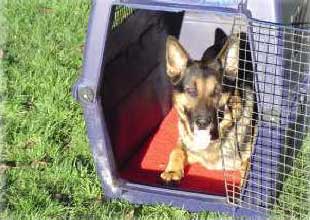How does crate training work?
What is the big deal about crate training? Why would I ever need it? Well, what do you plan on doing if you ever want to bring your dog into your house when he is not yet fully house trained?
Crate training your dog or puppy is not easy and will take some time and effort, this I promise you. But if you take the time to properly train your dog to use the dog crate your dog will be happy to spend time there whenever needed in the future.
Whenever using a crate it is very important to avoid making your dog or puppy feel isolated or banished from its "pack". It is a good idea to put the crate in an area of your home that does have a good bit of traffic such as your kitchen, living room, etc. and in a place free from drafts but not too close to a direct heat source.
What is the best solution to this problem? A secure, safe, clean and comfortable area for your dog that is virtually disaster proof - resistant to possible destructive behavior and improper elimination. A dog crate!
The best solution I could ever offer you to to solve this problem would be the use of an airline type crate, carriers or cages, that you can easily find in pet stores or just about anywhere online. If you have a new dog or puppy, you could easily use the crate to limit his access to the house until he learns things like what he can and can't chew on and where he can (or can't) eliminate.

Even though many pet-care professionals, veterinarian offices, professional handlers, pet hobbyists, professional trainers, hunters and many others in the pet industry overwhelmingly approve of the use of crates or cages, many pet owners still believe that using a crate is somehow harmful to their pets.
Believe it or not, but dogs and cats prefer to curl up for hours at a time in the darkest, smallest, most quiet spaces that they can find. Haven't you ever noticed that? Now, add a lot of positive reinforcement for getting in and staying quietly in the crate and you're well on your way to a positive learning experience for you both as well as a safe place for your pet to rest while crate training.
Dog Crate positive uses. Here are just a few:
1) they can prevent your puppy from chewing on inappropriate items when you are unable to keep an eye on them,
2) they create an "accident-free zone" for your puppy,
3) they provide a safe space for the pet to relax and rest,
4) it can help to reduce separation anxiety,
5) it can keep a puppy away from dangerous household items,
6) it can serve as a mobile indoor dog house when needed,
7) it makes your dog easier to travel with by car or plane.

Cages made out of that heavy, covered wire are airy and allow breezes to easily pass through but can easily rust in wetter climates and are quite open. Also, these types of cages do not offer any kind of protection from the elements. It is possible to now find models that offer an attractive and protective fabric cover that fits over the wire cage making crate training easier and your puppy less insecure from being out in the open.
Now you can find dog crates or cages in a variety of styles and different sizes - not just that airline crate style that many of us are so familiar with. All designs have pros and cons. Those flight kennels made of aluminum can stand up to almost any type of abuse but are hot in warm weather.
The one I have used for years (and own several of) is the hard, pre-formed plastic kennel with a heavy wire door. You can find these almost everywhere as well. Why do I like these? For one thing they can be stacked on top of each other. They are also very easy to clean and sterilize and they can be easily be taken apart for storage purposes if needed - the top and bottom halves of the crate easily fit inside each other and are easy to store - and they last forever.
Prices vary for crates depending on the style and size you purchase for your dog - from just a few dollars for an inexpensive cat carrier to well over several hundred dollars for a crate big enough for a full grown Saint Bernard. You can easily find crates all over - in many pet shops, through wholesale pet catalogs, at dog or cat shows and especially on the internet.
A Few Basic Crate Training Tips:
• NEVER EVER use the crate when you are disciplining your puppy or are punishing it for some reason!
You do not want the puppy to ever create a negative association with the crate or with it being in the crate.
Also, do not let the puppy out of the crate when it is being fussy. Train the puppy to be quiet and patient and it will be let out.
If you let it out when it is "acting up" during crate training you will train it to act up to get out and this is not what you want either. Once you've taught it this, it is very hard to retrain the quiet behavior that you want while being crated.
• Start crate training your new puppy as early as possible. Your puppy will have much less trouble becoming crate trained if you start it out as early as possible. In this way the puppy will be used to the crate and will accept it as it's "room" - causing you much less trouble when you need to confine the adult dog later.
• Start with short periods of crate confinement and with lots of praise. Make it a game so that the puppy will enjoy the crating process. You can begin with just a few seconds at a time and then gradually increase the amount of time the animal must remain in the crate over a long period of time. Give your puppy a blanket (with your smell on it), toys or a treat.
The amount of time you can safely keep your puppy in a crate (once trained) each day should be determined by the dogs age. A small puppy can not be expected to "hold it" for long periods of time. Begin crating your puppy for a few minutes at a time while crate training. As the puppy ages you can increase the time it is in the crate.
One good rule of thumb is to remember your puppies age in months, for example, 3 months old, and then to associate the puppies age with the number of hours you could expect your puppy to "hold it" - 3 hours in this example. Other examples: 4 months of age = 4 hours, 5 months of age = 5 hours but do not go past 6 hours in the crate no matter how old the puppy or dog is. 6 hours in a crate is the maximum length of time any dog should remain crated for one session.
When leaving put your puppy in the crate as the last thing you do just
before you leave and do not make a big fuss. Once full grown and
completely crate trained, an average of six hours per day can be safely
maintained almost indefinitely if needed. I would never, ever suggest
going past this time amount however and afterward the dog should be given lots of exercise and personal attention.
Longer periods of time being crated can cause a lot of health and behavioral problems. Bladder
infections and many other health problems can result from having to
consistently "hold it" for long periods of time. Also, if you make the
puppy or dog have to hold it to long chances are it will eventually
eliminate out of pure desperation and need. Once the puppy or dog has
lost its inhibition concerning soiling its crate, it is very difficult
to correct this problem.
• Dog Crates are an ideal tool when you're traveling. Crate-trained pets are allowed at many hotels and motels. They also allow you extra security for your pet in case of an unexpected breakdown or any other kind of emergency that might happen.
• Make sure the crate is big enough for your dog - but not too big. If you have a puppy, ask your breeder or veterinarian to help you estimate the adult size of your pet.
If you get a crate large enough for your dog as an adult make sure that you partition off the entire crate area to accommodate the puppy at it's current size - this could then change as the puppy grows. If you give a small puppy a very large area to stay crated in it may relieve itself in one area and sleep in another. And once this habit has been established while crate training it is very hard to break. Avoid this problem entirely by allowing the puppy only an area large enough to stand, sleep and turn around in when crated.
The Dog Crate must be at least as long as the puppy is from the base of the skull to the base of the tail and at least as tall as its height from the top of its shoulders to the ground. Also, it is perfectly fine for the dog to have to stoop a little when getting into the crate during crate training.
If you use all these dog crate training tips you and your pet should learn the process and be able to follow it in no time. Crate training provides a safe haven for your puppy as it matures and is an invaluable tool for the pet owner. For more advice on using a crate as a training aid, speak with a professional dog trainer or your veterinarian.
Return from crate training a German Shepherd to GSD puppy info
"A really companionable and
indispensable dog is an accident of nature. You can't get it by
breeding for it, and you can't buy it with money. It just happens
along." - E B White, The Care and Training of a Dog
Sign up for promotions, news, discounts, and the chance to win prizes for you and your German Shepherd

